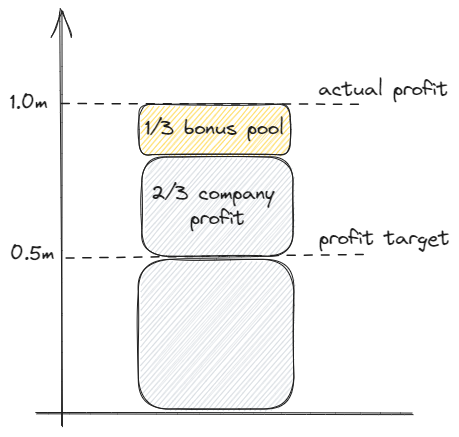Your cart is currently empty!
Profit sharing
Profit sharing among employees can increase ownership, accountability, and performance. If structured and communicated properly, it unlocks performance potential by inducing employees in search for growth or profitability measures.
The profit sharing can structured around operating profit, gross margin, or cost savings.
Example #1:
Company sets a profit target of $0.5 mil. It allocates 1/3 of ‘anything above the profit target’ to a bonus pool. The bonus pool is distributed to employees to cover their bonus. The bonus is always distributed pro-rata based on everybody’s (fixed) salary.

There are 3 attributes to profit sharing:
i) profit target
You need to set realistic goals. Test your goals by creating realistic scenarios of what needs to happen to achieve the goal.
ii) size of employee bonus
How much money can employees get in bonus if company is in profit? Example: employees can make an extra monthly salary if company is in profit
iii) profit share
How much profit do you keep or share? This will be calculated in a few iterations, where you compare the total cost of bonuses, company’s expected profit, and company’s capital requirements.
Example #2:
Company sets a profit target of $0.5 mil. It allocates 1/3 of ‘anything above the profit target’ to a bonus pool. Employees can earn 1 extra monthly salary from the Profit sharing. If bonus pool does not cover full monthly salaries, employees get pro-rata share of available money.
You can distribute profit sharing also on quarterly basis. Just set quarterly profit targets and recalculate profit sharing and bonus pool to quarterly salaries. In a sum, profit sharing bonus should amount up to 15% of annual pay.
Example #3:
Company sets quarterly profit target of $0.125 mil. It allocates 1/3 of ‘anything above the profit target’ to a bonus pool. Each quarter employees can earn up to 25% extra monthly salary from the Profit sharing. If everything goes well, employees make 4x 25% monthly salary = 1 extra monthly salary in year. Each quarter actual profits are compared to profit targets. 1/3 of anything above is allocated to quarterly bonus pool and distributed to cover 25% of monthly salaries. Not more. If not enough money is available, bonus pool is distributed on pro-rata basis.
Critical considerations:
- profit sharing can be based on free cash flow, EBITDA, operating profit, or any non-gaap metric
- recommended frequency: 6 months or quarterly
- quarterly results are cumulative, i.e. loss in Q1 is forwarded to results in Q2. Also, bonus for Q1 is recognized as expense in Q2 results.
- if bonus pool is greater than (capped) bonuses, undrawn bonus pool is not brough forward to next period